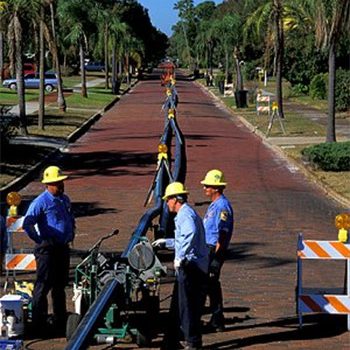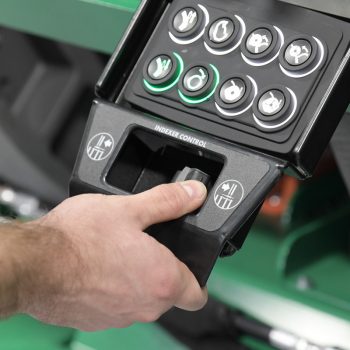Due to the reputation of producing the most reliable, durable and best-engineered fusion equipment available; McElroy Manufacturing, Inc. decided to go yet another step to insure their new TracStar line of fusion equipment would perform anywhere their customers demand.
High altitude can encumber engines. And being poised at 12,000 feet ready to butt-fuse a length of polyethylene, is not a good time to find out the generator will not perform. MMI decided to take their TracStar 28 and TracStar 412 to the top of Pikes Peak to insure their equipment could fuse pipe at high altitudes.
The TracStar 28 is an engineering blend of the best parts of the 28 fusion machine and 28 Pit Bull in-ditch fusion machine. Designed with a removable jaw assembly, all terrain mobility, and an on-board generator, this machine is versatile enough to attack any fusion problem. It is designed to fuse 2″ IPS through 8″ DIPS.
New improvements to the 412 are the track system and diesel power. The low maintenance diesel engine delivers ample power to this 4″ IPS through 12″ DIPS fusion machine. Perhaps the biggest improvement the TracStar brings to the industry is added mobility. Manipulating a machine around pipe in the field can be very time consuming. With the track system, maneuvering through almost any terrain to perform butt fusion joints is much easier and faster.
Purpose
At high altitudes engines suffer loss of horsepower due to reduced air pressure. To find the capabilities of the TracStar 28 and TracStar 412, a test was devised to determine what would be required to successfully operate the machines over a range of altitudes.
Test procedure
The test procedure required taking production machines from near sea level to 14,200 ft while testing them for easy starting and running at idle and at full speed under load. Max. load was established with the engine at maximum operating speed, the heater on and facing the largest rated diameter pipe with enough facing pressure to cut a continuous ribbon.
TracStar 28
To compensate for high altitude, gasoline engines need to be adjusted to avoid too rich a fuel/air mixture. For the Model 340K1, Honda recommends changing to a .082 main jet (part number 99101-ZH8082) at altitudes above 5000 ft. At altitudes above 8,000ft they recommend a .080 main jet (part number 99101-ZH8-080). We tested this recommendation from sea level to 14,200 ft. The T28, with the recoil starter, started and ran under load throughout this range of altitudes.
Making the modification is easy for an experienced mechanic. Simply drain the fuel bowl and remove it. Screw the jet out of the hole that the bowl attachment bolt screws into. Install the smaller jet and reassemble the engine. It will take a few pulls on the starter to fill the bowl, but it will run normally.
Care should be exercised on machines that will be used over a range of altitudes. Once an engine has been adjusted for altitude it can overheat due to the lean mixture if operated at low altitude. There may be no other signs before engine damage occurs.
Test results and notes
.090jet – Factory configuration
- 6,000 ft – no problems starting or running under load
.082 jet
- 8,400 ft – no problems starting or running under load
.080 jet
- 8,400 ft – no problems starting or running under load
- 11,000 ft – no problems starting or running under load
- 12,400 ft – no problems starting or running under load
- 14,200 ft – no problems starting or running under load
TracStar 412
Diesel engines are adjusted for high altitude by advancing the fuel injection timing. This gives the engine more time to burn the fuel before it is expelled. At high altitude engines are noisier, have difficulty accelerating and have reduced power output. Also, the rich mixture can generate black smoke, which indicates incomplete combustion or in extreme cases white smoke, caused by raw fuel in the exhaust.
Yanmar recommends advancing the timing from 20 deg. to 23 deg. for use above 9000 ft. Increasing the thickness of the shim between the cam follower and the fuel injection pump does this. Yanmar plate pack # 118200-14700 is required to make the change. This shim is also used to adjust each engine from the factory for manufacturing tolerances, therefore, each engine, and in fact each cylinder, may have a different thickness shim. Standard timing for the 2V78 is 19 to 21 deg BTC. In the test unit the shim was increased to .15 mm to achieve a 4 deg advance in timing to 24 deg. The unit ran normally and performed under load up to 8400 ft without modification. With the advanced timing the unit started and handled the load from 8400 ft up to 14,200 ft. Above 10,000 ft. it generated black smoke under the combined load of the heater and facer, but did not slow or stall and had good throttle response.
This adjustment is complicated and there is significant risk of dropping the shim into the crankcase as well as a risk of disengaging the fuel rack from the governor. If either of these happens severe engine damage will result. MMI recommends having a Yanmar service personnel make this adjustment.
Modified engines should not be run at low altitudes. Overheating and engine damage may result.
Test results and notes
Timing at 20 degrees:
- 6,500 ft – No problem starting and running under load
- 8,400 ft – No problem starting and running under load – seemed more noisy (diesel clatter) especially at idle
Timing at 24 degrees:
- 8,400 ft – No problem starting and running under load – quieter but black smoke under combined load of heater and facer
- 10,000 ft – No problem starting and running under load – less smoke
- 11,500 ft – No problem starting and running under load
- 13,000 ft – No problem starting and running under load
- 14,200 ft – No problem starting and running under load – still smoking but no lack of power
Cold weather
Ambient temperature at 14,200 ft was 55 deg. Often, when operating at that altitude cold weather starting may be a problem. Refer to the cold weather starting guidelines for the TracStar 500 in these conditions. There is no block heater available for this engine but other methods such as a battery blanket, fuel additive, and heated dipstick can be used.

